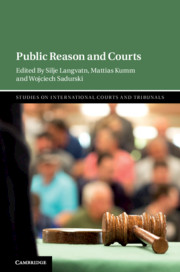Book contents
- Public Reason and Courts
- Studies on International Courts and Tribunals
- Public Reason and Courts
- Copyright page
- Contents
- Contributors
- Preface
- Acknowledgments
- 1 Taking Public Reason to Court: Understanding References to Public Reason in Discussions about Courts and Adjudication
- Part I Public Reason in Constitutional Courts
- 2 Must Laws Be Motivated by Public Reason?
- 3 The Importance of Constitutional Public Reason
- 4 The Question of Constitutional Fidelity: Rawls on the Reason of Constitutional Courts
- 5 The Challenges of Islamic Law Adjudication in Public Reason
- 6 “We Hold These Truths to Be Self-Evident”: Constitutionalism, Public Reason, and Legitimate Authority
- 7 A Kantian System of Constitutional Justice: Rights, Trusteeship, Balancing
- 8 Laws, Norms, and Public Justification: The Limits of Law as an Instrument of Reform
- Part II Public Reason in International Courts and Tribunals
- Part III Critical Perspective on Public Reason in Courts
- Index
8 - Laws, Norms, and Public Justification: The Limits of Law as an Instrument of Reform
from Part I - Public Reason in Constitutional Courts
Published online by Cambridge University Press: 22 May 2020
- Public Reason and Courts
- Studies on International Courts and Tribunals
- Public Reason and Courts
- Copyright page
- Contents
- Contributors
- Preface
- Acknowledgments
- 1 Taking Public Reason to Court: Understanding References to Public Reason in Discussions about Courts and Adjudication
- Part I Public Reason in Constitutional Courts
- 2 Must Laws Be Motivated by Public Reason?
- 3 The Importance of Constitutional Public Reason
- 4 The Question of Constitutional Fidelity: Rawls on the Reason of Constitutional Courts
- 5 The Challenges of Islamic Law Adjudication in Public Reason
- 6 “We Hold These Truths to Be Self-Evident”: Constitutionalism, Public Reason, and Legitimate Authority
- 7 A Kantian System of Constitutional Justice: Rights, Trusteeship, Balancing
- 8 Laws, Norms, and Public Justification: The Limits of Law as an Instrument of Reform
- Part II Public Reason in International Courts and Tribunals
- Part III Critical Perspective on Public Reason in Courts
- Index
Summary
Critics of public reason liberalism often object that a commitment to the public justification of law is too conservative: It prohibits the passage of controversial reforms. Laws that would promote justice are thwarted by recalcitrant but reasonable citizens. This objection presupposes a popular but empirically false theory of legal regulation on which laws affect behavior primarily through the threat of punishment. Against this position, this chapter argues that laws effectively regulate behavior when they cohere with social norms but are typically ineffective and sometimes counterproductive when they conflict with them. And laws and social norms are stable only when they approximate public justification. So, laws do not possess the autonomy and power that critics of public reason liberalism suppose. Without public justification, justice is difficult to secure and, if secured, is all-too-likely to be fragile.
Keywords
- Type
- Chapter
- Information
- Public Reason and Courts , pp. 201 - 228Publisher: Cambridge University PressPrint publication year: 2020
- 7
- Cited by



